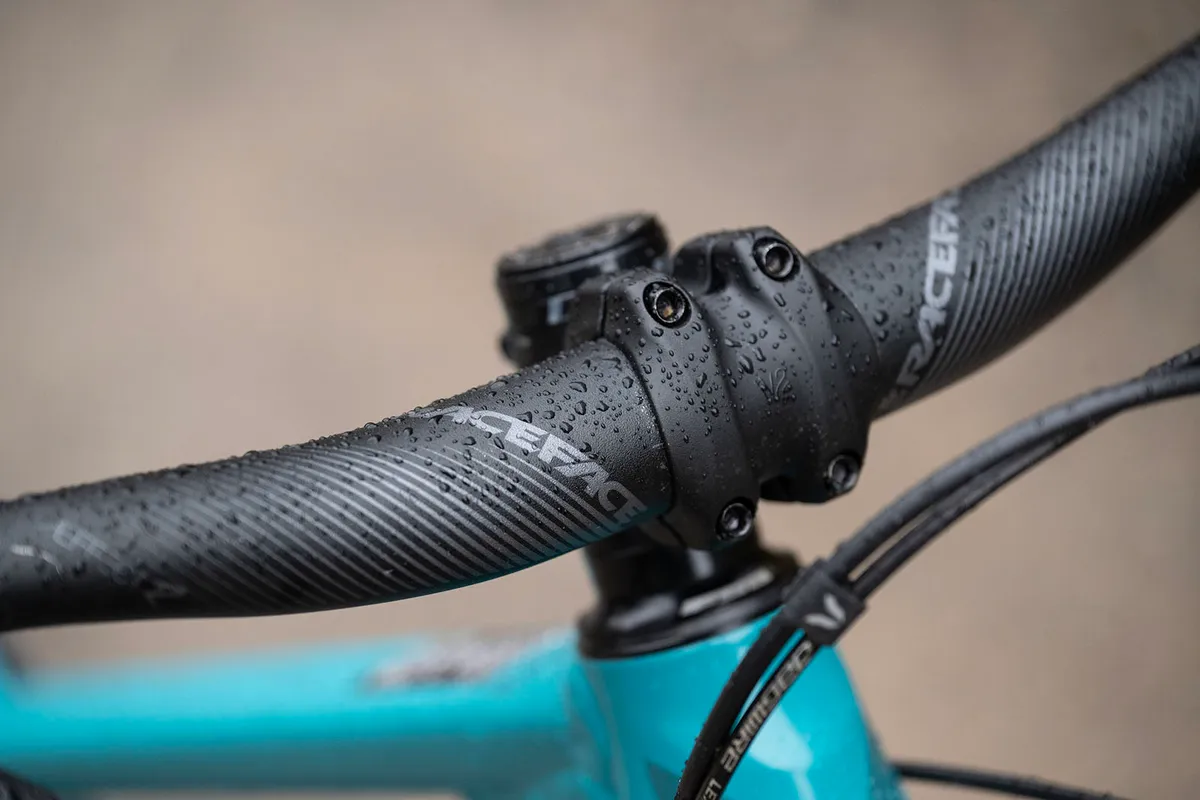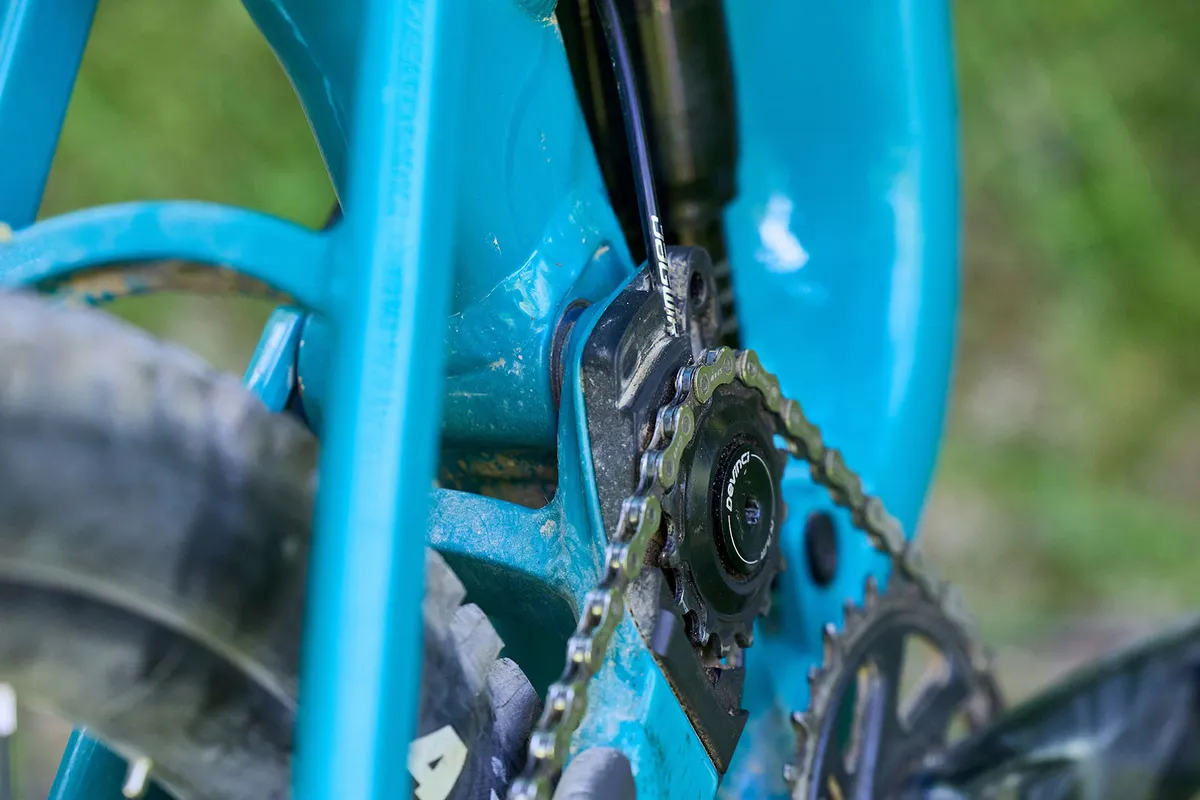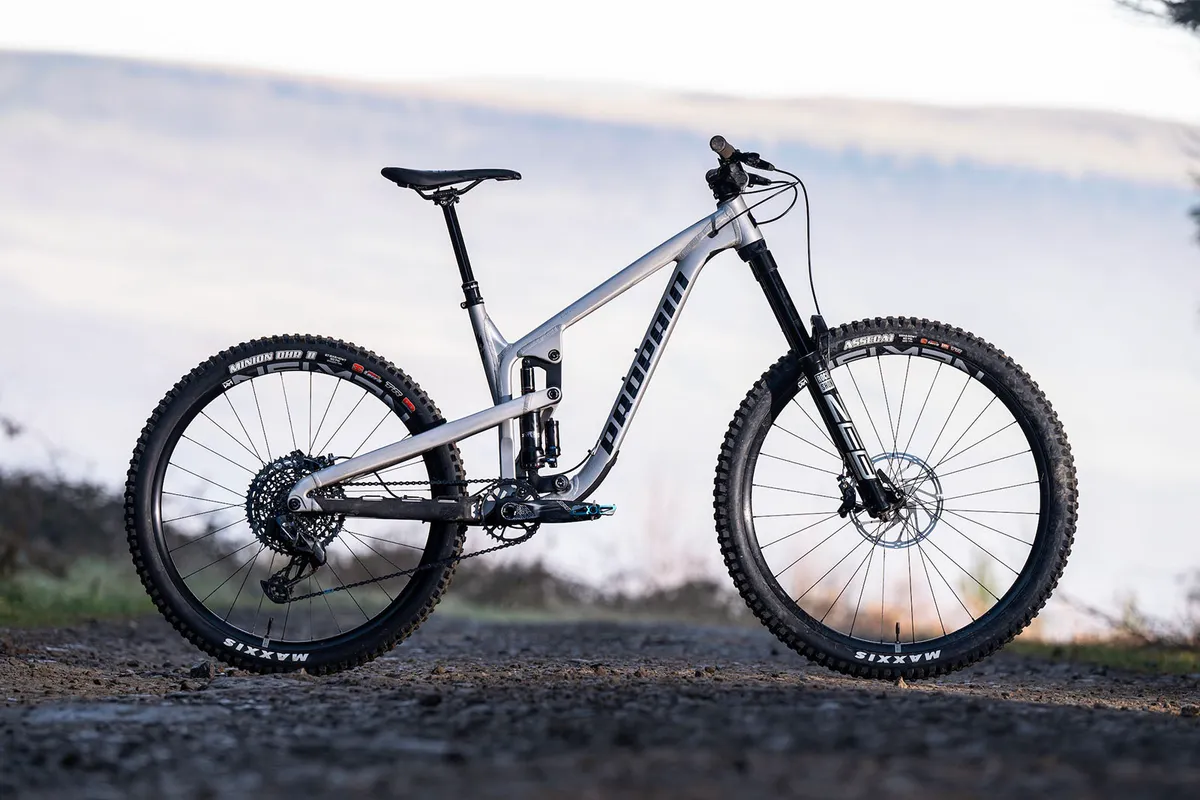Devinci has built the Chainsaw GX 12S for good times, and to help riders with more modest budgets own a shred-ready bike for thrashing out laps of the bike park and seeking out the wildest, steepest enduro lines.
This aluminium high-pivot bike with a chain idler dishes out 170mm of travel and rolls on 29in wheels. It has suitably long, low and slack geometry for its aggressive nature, and well thought-out components to manage performance and price.
The name isn’t a coincidence. The Chainsaw’s design philosophy takes inspiration from the late, great Steve Smith and his infectious enthusiasm for high speeds and good times.
Proceeds from Chainsaw sales will be donated to the Steve Smith Legacy Foundation. This Foundation was set up to inspire and help the next generation of Canadian gravity athletes.
If you’re looking for a wild ride, the Chainsaw might just be up your street.
Devinci Chainsaw GX 12S frame and suspension

Built with 6061-T6 aluminium tubing to balance strength and weight, the Chainsaw is welded in Canada and comes with a lifetime warranty, which is impressive considering its price tag.
The bike's 170mm of travel is delivered by a high single-pivot, linkage-driven design with a chain idler. This configuration uses Devinci’s version of a Split Pivot linkage, where the rear pivot is concentric to the rear axle.
Devinci hasn’t published any information about its kinematics, but considering the placement of the main pivot I expect the frame should have a rearward axle path for most of its travel, which finishes just forwards of vertical at the end of the stroke.
The frame can be run with a coil or air shock, so there should be a reasonable amount of progression to provide some bottom-out resistance.
The idler is offset to the main pivot, so Devinci has used this to help tune the pedalling characteristics of the bike. It spins on a low-friction bearing to help minimise friction in the drivetrain.

My test model rolls on 29in wheels, but there is a flip chip in the lower shock mount that should allow you to run a 650b rear wheel, while keeping the geometry similar.
There’s space for a 500ml water bottle inside the front triangle. The cables run internally though the down tube, with some neat routing through the idler to minimise cable stretch during suspension compression.
There’s a threaded bottom bracket and space for 29x2.5in rear tyres. The frame uses the 12x157mm Super Boost rear-hub spacing, with a Boost 56.5mm chainline.
Devinci Chainsaw GX 12S geometry

Devinci hasn’t held back when it comes to building a bike that’s not going to shy away from the wildest trails out there.
The size-medium bike I tested features a 469mm reach, which is towards the longer end of medium frames. When matched to the slack 62.9-degree head tube angle, there should be plenty of stability from the front centre.
The reach is paired with a short 430mm chainstay. However, due to the rear axle path, you can expect this to be longer when you’re riding the bike.
The upright 79.4-degree effective seat tube angle should seat riders in a position that will help them grind up steep hills in relative comfort. Along with the head tube angle, it gives a moderate 586mm effective top tube length, considering the reach value, meaning riders shouldn't feel too stretched out when seated.
The seat tube length is a reasonable 435mm, so a long dropper post can be used. The 623mm stack is perhaps lower than expected for a downhill bike, but it's not so low as to cause concern.
| | S | M | L | XL | |
|---|---|---|---|---|---|
| Seat angle (degrees) | 79.9 | 79.4 | 78.9 | 78.4 | |
| Head angle (degrees) | 62.9 | 62.9 | 62.9 | 62.9 | |
| Chainstay (mm) | 425 | 430 | 435 | 440 | |
| Seat tube (mm) | 405 | 435 | 450 | 470 | |
| Top tube (mm) | 558 | 586 | 619 | 651 | |
| Head tube (mm) | 95 | 105 | 115 | 125 | |
| Bottom bracket height (mm) | 342 | 342 | 342 | 342 | |
| Wheelbase (mm) | 1,228 | 1,257 | 1,292 | 1,327 | |
| Standover (mm) | 717 | 717 | 717 | 717 | |
| Stack (mm) | 614 | 623 | 632 | 641 | |
| Reach (mm) | 449 | 469 | 494 | 519 |
Devinci Chainsaw GX 12S specifications

Devinci has decked out the Chainsaw GX 12S with some smart spec choices to help keep the price down.
It uses a RockShox ZEB Rush RC fork. The Rush RC damper is similar to the Charger damper and uses a solid cartridge with an IFP (Internal Floating Piston) backed piston that has externally adjustable low-speed compression and rebound damping.
On the rear, there’s a RockShox Super Deluxe Select R shock with externally adjustable rebound adjustment.

Naturally, there’s a full SRAM GX Eagle drivetrain, alongside SRAM G2 RE brakes, which combine a G2 R lever with a caliper derived from the gravity-focused Code 4-pot. There are 200mm rotors.
The Chainsaw rolls on Race Face AR30 rims, laced with Sapim spokes to Factor hubs.

These are shrouded in Maxxis Minion DHF 3C MaxxTerra EXO+ 29x2.4in front and Maxxis Minion DHRII 3C MaxxGrip DoubleDown 29x2.4in rear tyres.
The cockpit combines a Race Face Aeffect 35 handlebar, V2 Pro stem and Devinci lock-on grips. There’s a TranzX dropper post and SDG FLY MTN saddle to finish off a competent build kit.
This all weighs in at a respectable 16.3kg, without pedals.
Devinci Chainsaw GX 12S ride impressions

I tested the Chainsaw GX 12S over multiple days at BikePark Wales, taking in the roughest and rowdiest black trails though to more fun and flowy blue runs. Conditions ranged from wet slop to bone-dry dust.
The Chainsaw also saw plenty of off-piste natural tech trails around the Forest of Dean and South Wales.
For my 75kg weight, I ran 65psi in the forks with the one stock volume spacer. This gave me plenty of initial suppleness, with good support deeper in the stroke from RockShox's latest DebonAir+ air spring.

I left the three-position compression in open most of the time, but its middle setting is usable for more support on smooth trails with plenty of high-load compressions.
If you want a firm pedalling platform, the firmest setting will be useful too.
I ran the rebound damping eight clicks from closed out of 20, although after 10 clicks I couldn’t feel a difference.

While the bike’s info sticker (a smart feature that would be good to see on more bikes) recommends 20-25 per cent sag, when I spoke to Devinci, the brand recommended I set the Chainsaw up with a more common 30 per cent.
I needed 145psi in the shock to get 30 per cent sag. This was good for enabling me to occasionally access full travel without blowing through the travel often. I set the rebound adjustment eight clicks from closed out of 12.
Devinci Chainsaw GX 12S climbing performance

When I took this bike on the trails for its first rides, it was one of the worst-pedalling bikes I’ve ridden. There was so much drag in the drivetrain, it was a noticeable hindrance.
I set the chainring's lower roller to its lowest height setting to help ease chain tension, and I took apart the idler to check for drag.
In the end, I removed the lower chain guide completely and that made an enormous difference. I hope Devinci can amend this, but I recommend removing it if you want to pedal the bike.

Once I’d sorted the drag, the bike pedalled reasonably considering its drivetrain layout.
The idler jockey wheel adds a small amount of resistance, but the shortened length between the idler and cassette, compared to a non-idler bike’s chainring and cassette, means the chain is pulled at a more acute angle in first gear. This seems to be a bigger cause of drag.
That said, the Chainsaw will get you up a hill comfortably without draining all your energy reserves. It might not be the quickest uphill, but that’s not its mission.
Even without a shock lockout, the bike pedals without too much bob when seated, and the position is comfortable on steep and long climbs. You could ride the Chainsaw all day.
Without a lockout, there’s plenty of traction when tackling bumpy singletrack climbs.
Devinci Chainsaw GX 12S descending performance

If climbing produces only average results, downhill this bike deserves gold stars. I believe it might be the fastest you can go for less than £5,000/$5,000.
While you might think the suspension is basic, RockShox has produced some capable kit, and Devinci has built a frame to eke out the best of it.
The rear end is something of an enigma. It soaks up bumps of all sizes and frequencies in the roughest trails, yet still delivers an engaging ride on smoother tracks.

The Chainsaw hasn’t quite conquered all trails though. Rough trails without much gradient, where you really need to work the bike, seem to be its Achillies heel.
It will get you through them, but it feels as though you need more energy expenditure to maintain speed than with a non high-pivot bike.
The Chainsaw GX 12S comes alive when gravity is on your side. No matter how rough or steep the trail, once this bike is up to pace, it doesn’t want to slow down.

The rear suspension and high pivot do a brilliant job of isolating the rider from trail feedback, providing a stable bike with which to charge into the next rough section.
Whether it’s large square-edge bumps, or high-frequency trail chatter, the rear end stays composed and smooth. This enabled me to concentrate less on the bike and more on the trail.
Through deep compressions and high-load turns, there’s enough compression in the suspension that there’s good support, and the bike doesn’t feel as if it wallows or robs you of speed.

It’s not as much fun as every 170mm-travel bike on the blue trails, but its stability is mesmerising and enables you to charge whatever trail you’re on.
Talking of charging, it’s best to ride the Chainsaw with gusto. The long reach and slack head tube angle result in a bike that needs to be ridden with commitment to the front wheel to help it track where you want it to go.
This is the case more so on mellower trails, where understeer is more noticeable if you don’t remain committed to the front end.

On steeper trails, this long front centre promotes staying centred on the bike, which gives it impressive handling.
The bike feels planted to the ground when gradients increase, thanks to that competent suspension and aggressive geometry. I found it wasn’t the bike holding me back when the trails became wilder.
I was thoroughly impressed by the RockShox suspension specced. While it might not have the glitz and glamour (read adjustability) of higher-end models, both the fork and shock are very capable.

The fork doesn’t quite have the same square-edge bump absorption as higher-end models, and there’s a bit more of a spike in the travel on hard impacts, but it’s only a small fraction behind more adjustable units.
The only issue with the shock is it would be nice to have a climb switch to help the Chainsaw up the climbs.
SRAM’s GX Eagle is a proven performer and caused no issues on the trails, and the G2 RE brakes have decent bite. However, my test brakes faded on steeper, longer trails.

A bleed would probably cure this, however.
My first upgrade would be some more comfortable grips, otherwise the bike is good to go and didn’t cause me concern, other than the lower chainguide issue.
I never dropped a chain without it, but chain wrap around the chainring is limited when it’s removed.

A final oddity was the Maxxis MaxxGrip compound rear tyre and Maxxis MaxxTerra compound at the front. It may be a ‘what’s available’ situation for Devinci.
If it was my bike, however, I'd swap the faster-rolling Minion DHF to the rear and the grippier DHR II to the front.
I don't think there would be any issues with grip or braking running the tyres in that configuration.
How does the Devinci Chainsaw GX 12S compare to the Propain Spindrift Al Performance MX?

Both these bikes are intended for park duties and have long-travel aluminium frames. The Propain Spindrift, with its PRO10 suspension platform and less aggressive geometry, offers a better all-round ride.
It’s the more versatile of the two bikes and happy at most speeds on any trail. It can still fly down the trail, but its ceiling for all-out speed is perhaps lower.
The long, slack, bump-swallowing Devinci shines when trails get gnarly. If you want the most control on the wildest trails, and to be able to always push to 11, the Chainsaw will have your back.
It can do all the other types of riding too, but it is less well rounded than the Spindrift.
Devinci Chainsaw GX 12S bottom line

The Chainsaw GX 12S is a brilliant bike at what it's designed for – to suit aggressive riders smashing out park laps and heading off to the occasional backcountry enduro trail.
If you’re looking for a seasonaire bike, this would be a great platform and one you can upgrade from.
The steeper and faster you ride it, the more this bike will reward you. It will be difficult to find the bike's limits, and I’m sure it will also tear up the odd downhill race if needed.
Product
| Brand | Devinci |
| Price | $4999.00 |
| Weight | 16.30kg |
Features
| Fork | RockShox ZEB Rush RC, 170mm travel |
| Stem | V2 Pro, 40mm |
| Frame | Aluminium, 170mm travel |
| Tyres | Maxxis Minion DHF 3C MaxxTerra EXO+ 29x2.4in front, Maxxis Minion DHR II 3C MaxxGrip DoubleDown 29x2.4in rear |
| Brakes | SRAM G2 RE, 200mm rotors |
| Cranks | SRAM GX Eagle |
| Saddle | SDG FLY MTN |
| Wheels | RaceFace AR30 |
| Headset | FSA Orbit |
| Shifter | SRAM GX Eagle |
| Cassette | SRAM XG1275, 12s, 10-52t |
| Seatpost | TranzX dropper, 150mm/SDG FLY MTN |
| Grips/tape | Devinci Performance |
| Handlebar | RaceFace Aeffect, 780mm |
| Rear shock | RockShox SuperDeluxe Select R |
| Bottom bracket | SRAM DUB BSA73 |
| Available sizes | S, M, L, XL |
| Rear derailleur | SRAM GX Eagle |
